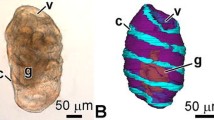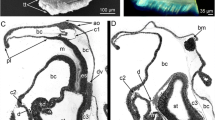Abstract
The structure of the late doliolaria, pentactula and 1-month-old juvenile of the holothurian Apostichopus japonicus was studied using light microscopy and 3D reconstruction methods. It was shown that metamorphosis in this species consists in the reorganization of the shape of the body and the destruction of provisional organs. The late doliolaria has a spindle-like form, ciliary rings and hyaline spheres shifted relative to the anterior-posterior axis of the body. Some provisional organs (ciliary rings, hyaline spheres) are destroyed during settlement, and others (hydropore and hydroporic canal) remain after metamorphosis. Definitive organogenesis in A. japonicus begins long before metamorphosis. The late doliolaria already has well-developed water-vascular and digestive systems, and the ectoneural part of the nervous system. Muscle and hemal systems begin to form in the pentactula. Moreover, the calcareous ring and connective tissue part of the body wall develop at this stage. The pentactula has anlages of the hyponeural part of the nervous system, which form in the mid-ventral and dorsal nerve cords. The hemal ring of the pentactula is located on the inner wall of the water-vascular ring. It remains unclosed in the left ventral radius. One-month-old juveniles have all the major organ systems except respiratory and reproductive systems. The hemal vessels of the intestine are well developed and begin to form the rete mirabile. Differentiation of the intestine into regions due to differential specialization of the enterocytes begins in 1-month-old juveniles. Obviously, emergence of new types of enterocytes enables the animal to consume a wider range of food items and indicates its increased feeding activity.







Similar content being viewed by others
References
Brusca RC, Brusca GJ (2003) Invertebrates, 2nd edn. Sinauer Associates, Sunderland
Byrne M (1986) The ultrastructure of the morula cells of Eupentacta quenquesemita (Echinodermata: Holothuroidea) and their role in the maintenance of the extracellular matrix. J Morphol 188:179–189
Cobb JLS (1995) The nervous systems of Echinodermata: recent results and new approaches. In: Breidbach O, Kutsch W (eds) The nervous systems of invertebrates: an evolutionary and comparative approach. Birkhäuser, Berlin, pp 407–424
Conand C (2008) Population status, fisheries and trade of sea cucumbers in Africa and the Indian Ocean. In: Toral -Granda V, Lovatelli A, Vasconcellos M (eds) Sea cucumbers. A global review of fisheries and trade. FAO Fisheries and Aquaculture Technical Paper. No. 516. FAO, Rome, pp 143–193
Dautov SS (1997) Structure and properties of hyaline spheres in holothuroid larvae. Invertebr Reprod Dev 32:155–161. doi:10.1080/07924259.1997.9672617
Dautov SS, Kashenko SD (1995) Hyaline spheres in auricularia of Stichopus japonicus. Invertebr Reprod Dev 27:61–64
Dietrich HF, Fontaine AR (1975) A decalcification method for ultrastructure of echinoderm tissues. Stain Technol 50:351–354
Dolmatov IY, Ivantey VA (1993) Histogenesis of longitudinal muscle bands in holothurians. Russ J Dev Biol 24:67–72
Dolmatov IY, Mashanov VS (2007) Regeneration in holothurians. Dalnauka, Vladivostok
Dolmatov IY, Mokretsova ND (1995) Morphology of pentactula Cucumaria japonica (Dendrochirota, Holothuroidea). Zoologicheskiy zhurnal 74:83–91
Dolmatov IY, Yushin VV (1993) Larval development of Eupentacta fraudatrix (Holothuroidea, Dendrochirota). Asian Mar Biol 10:125–134
Dolmatov IY, Mashanov VS, Zueva OR (2007) Derivation of muscles of the Aristotle’s lantern from coelomic epithelia. Cell Tissue Res 327:371–384
Dolmatov IY, Frolova LT, Zakharova EA, Ginanova TT (2011) Development of respiratory trees in the holothurian Apostichopus japonicus (Aspidochirotida: Holothuroidea). Cell Tissue Res 346:327–338
Drozdov AL, Kornienko ES, Kruchkova GA (1990) Oocyte maturation, development and metamorphosis in the Far eastern sea cucumber. Sov J Mar Biol 16:347–355
García-Arrarás JE, Dolmatov IY (2010) Echinoderms: potential model systems for studies on muscle regeneration. Curr Pharm Des 16:942–955
Herreid CF, LaRussa VF, DeFesi CR (1976) Blood vascular system of the sea cucumber, Stichopus moebii. J Morphol 150:423–451
Herreid CF, Defesi CR, Larussa VF (1977) Vascular follicle system of the sea cucumber Stichopus moebii. J Morphol 154:19–37
Hyman LH (1955) The invertebrates: Echinodermata. The coelome Bilateria. McGraw-Hill Book Co., New York
Ivanova-Kazas OM (1978) Comparative embryology of invertebrates. Echinodermata and Hemichordata, Nauka
Malakhov VV, Cherkasova IV (1991) The embryonal and early larval development of Stichopus japonicus var. armatus (Aspidochirota, Stichopodidae). Zool Zh 70:55–67
Malakhov VV, Cherkasova IV (1992) Metamorphosis of the sea cucumber Stichopus japonicus (Aspidochirota, Stichopodidae). Zool Zh 71:11–21
Mashanov VS, Dolmatov IY (2000) Developmental morphology of a holothurian Cucumaria japonica (Dendrochirota, Holothuroidea), a species with accelerated metamorphosis. Invertebr Reprod Dev 37:137–146. doi:10.1080/07924259.2000.9652412
Mashanov VS, Zueva OR, Heinzeller T, Aschauer B, Dolmatov IY (2007) Developmental origin of the adult nervous system in a holothurian: an attempt to unravel the enigma of neurogenesis in echinoderms. Evol Dev 9:244–256
McEuen FS, Chia F-S (1991) Development and metamorphosis of two psolid sea cucumbers, Psolus chitonoides and Psolidium bullatum, with a review of reproductive patterns in the family Psolidae (Holothuroidea: Echinodermata). Mar Biol 109:267–279
Menton DN, Eisen AZ (1973) Cutaneous wound healing in the sea cucumber, Thyone briareus. J Morphol 141:185–203. doi:10.1002/jmor.1051410206
Nakano H, Murabe N, Amemiya S, Nakajima Y (2006) Nervous system development of the sea cucumber Stichopus japonicus. Dev Biol 292:205–212
Podkorytov AG, Maslennikov SI (2015) The distribution of the far eastern trepang Apostichopus japonicus (Selenka, 1867) in the open aquatic area of Amur Bay (Sea of Japan) in terms of commercial load. Water Chem Ecol (9):49–57
Purcell SW (2010) Managing sea cucumber fisheries with an ecosystem approach. FAO Fisheries and Aquaculture Technical Paper. No. 520. FAO, Rome
Purcell SW, Samyn Y, Conand C (2012) Commercially important sea cucumbers of the world. FAO species catalogue for fishery purposes. No. 6. FAO, Rome
San Miguel-Ruiz JE, García-Arrarás JE (2007) Common cellular events occur during wound healing and organ regeneration in the sea cucumber Holothuria glaberrima. BMC Dev Biol 7:115. doi:10.1186/1471-213X-7115
Smiley S (1986) Metamorphosis of Stichopus californicus (Echinodermata: Holothuroidea) and its phylogenetic implications. Biol Bull 171:611–631
Smiley S (1994) Holothuroidea. In: Harrison FW, Chia FS (eds) Microscopic anatomy of invertebrates, vol 14., EchinodermataWiley-Liss Inc, New York, pp 401–471
Smiley S, McEuen FS, Chaffee C, Krishnan S (1991) Echinodermata: Holothuroidea. In: Giese AC, Pearse JS, Pearse VB (eds) Reproduction of marine invertebrates, vol 6., BoxwoodPacific Grove, CA, pp 633–750
Uthicke S, Byrne M, Conand C (2010) Genetic barcoding of commercial Bêche-de-mer species (Echinodermata: Holothuroidea). Mol Ecol Resour 10:634–646
Yang H, Hamel J-F, Mercier A (2015) The sea cucumber Apostichopus japonicus. History, Biology and Aquaculture. Elsevier, Amsterdam
Yoshida W, Tamai A, Yanaka T, Ishida S (2002) Normal development and artificial breeding of sea cucumber (Stichopus japonicus Selenka) from Mutsu Bay. Bull Fac Agric Life Sci Hirosaki Univ 4:16–23
Acknowledgments
The authors express their gratitude to two anonymous reviewers for the valuable comments, which enabled us to improve the quality of the paper. This study was supported by the Russian Science Foundation (Grant. 14-50-00034).
Author information
Authors and Affiliations
Corresponding author
Additional information
Communicated by A. Schmidt-Rhaesa.
Rights and permissions
About this article
Cite this article
Dolmatov, I.Y., Ginanova, T.T. & Frolova, L.T. Metamorphosis and definitive organogenesis in the holothurian Apostichopus japonicus . Zoomorphology 135, 173–188 (2016). https://doi.org/10.1007/s00435-015-0299-y
Received:
Revised:
Accepted:
Published:
Issue Date:
DOI: https://doi.org/10.1007/s00435-015-0299-y




